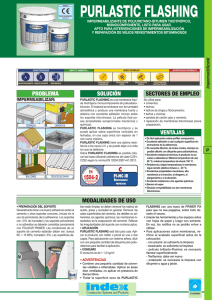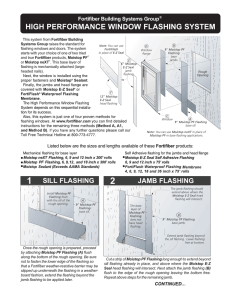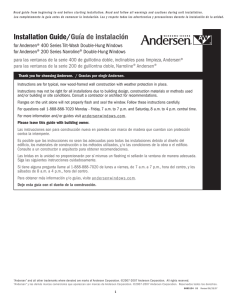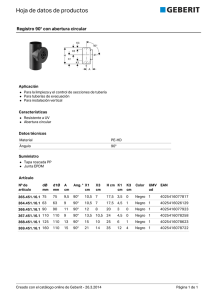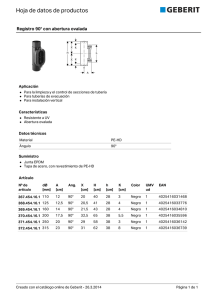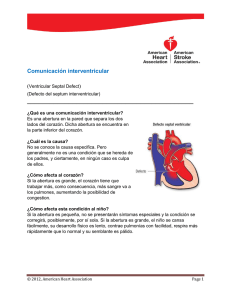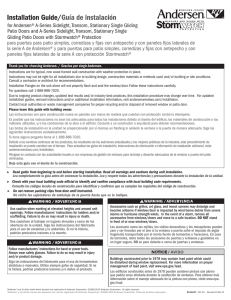Installation Instructions
Anuncio
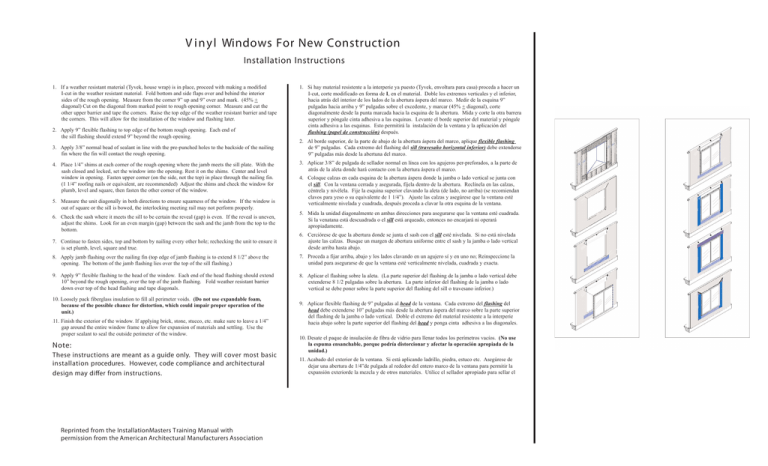
V i n y l Windows For New Construction Installation Instructions 1. If a weather resistant material (Tyvek, house wrap) is in place, proceed with making a modified I-cut in the weather resistant material. Fold bottom and side flaps over and behind the interior sides of the rough opening. Measure from the corner 9” up and 9” over and mark. (45% + diagonal) Cut on the diagonal from marked point to rough opening corner. Measure and cut the other upper barrier and tape the corners. Raise the top edge of the weather resistant barrier and tape the corners. This will allow for the installation of the window and flashing later. 2. Apply 9” flexible flashing to top edge of the bottom rough opening. Each end of the sill flashing should extend 9” beyond the rough opening. 3. Apply 3/8” normal bead of sealant in line with the pre-punched holes to the backside of the nailing fin where the fin will contact the rough opening. 4. Place 1/4” shims at each corner of the rough opening where the jamb meets the sill plate. With the sash closed and locked, set the window into the opening. Rest it on the shims. Center and level window in opening. Fasten upper corner (on the side, not the top) in place through the nailing fin. (1 1/4” roofing nails or equivalent, are recommended) Adjust the shims and check the window for plumb, level and square, then fasten the other corner of the window. 5. Measure the unit diagonally in both directions to ensure squarness of the window. If the window is out of square or the sill is bowed, the interlocking meeting rail may not perform properly. 6. Check the sash where it meets the sill to be certain the reveal (gap) is even. If the reveal is uneven, adjust the shims. Look for an even margin (gap) between the sash and the jamb from the top to the bottom. 1. Si hay material resistente a la interperie ya puesto (Tyvek, envoltura para casa) proceda a hacer un I-cut, corte modificado en forma de I, en el material. Doble los extremos verticales y el inferior, hacia atrás del interior de los lados de la abertura áspera del marco. Medir de la esquina 9” pulgadas hacia arriba y 9” pulgadas sobre el excedente, y marcar (45% + diagonal), corte diagonalmente desde la punta marcada hacia la esquina de la abertura. Mida y corte la otra barrera superior y póngale cinta adhesiva a las esquinas. Levante el borde superior del material y póngale cinta adhesiva a las esquinas. Esto permitirá la instalación de la ventana y la aplicación del flashing (papel de construcción) después. 2. Al borde superior, de la parte de abajo de la abertura áspera del marco, aplique flexible flashing de 9” pulgadas. Cada extremo del flashing del sill (travesaño horizontal inferior) debe extenderse 9” pulgadas más desde la abertuna del marco. 3. Aplicar 3/8” de pulgada de sellador normal en línea con los agujeros per-preforados, a la parte de atrás de la aleta donde hará contacto con la abertura áspera el marco. 4. Coloque calzas en cada esquina de la abertura áspera donde la jamba o lado vertical se junta con el sill. Con la ventana cerrada y asegurada, fíjela dentro de la abertura. Reclínela en las calzas, céntrela y nivélela. Fije la esquina superior clavando la aleta (de lado, no arriba) (se recomiendan clavos para yeso o su equivalente de 1 1/4”). Ajuste las calzas y asegúrese que la ventana esté verticalmente nivelada y cuadrada, después proceda a clavar la otra esquina de la ventana. 5. Mida la unidad diagonalmente en ambas direcciones para asegurarse que la ventana esté cuadrada. Si la venatana está descuadrada o el sill está arqueado, entonces no encarjará ni operará apropiadamente. 7. Continue to fasten sides, top and bottom by nailing every other hole; rechecking the unit to ensure it is set plumb, level, square and true. 6. Cerciórese de que la abertura donde se junta el sash con el sill esté nivelada. Si no está nivelada ajuste las calzas. Busque un margen de abertura uniforme entre el sash y la jamba o lado vertical desde arriba hasta abajo. 8. Apply jamb flashing over the nailing fin (top edge of jamb flashing is to extend 8 1/2” above the opening. The bottom of the jamb flashing lies over the top of the sill flashing.) 7. Proceda a fijar arriba, abajo y los lados clavando en un agujero sí y en uno no; Reinspeccione la unidad para asegurarse de que la ventana esté verticalmente nivelada, cuadrada y exacta. 9. Apply 9” flexible flashing to the head of the window. Each end of the head flashing should extend 10” beyond the rough opening, over the top of the jamb flashing. Fold weather resistant barrier down over top of the head flashing and tape diagonals. 8. Aplicar el flashing sobre la aleta. (La parte superior del flashing de la jamba o lado vertical debe extenderse 8 1/2 pulgadas sobre la abertura. La parte inferior del flashing de la jamba o lado vertical se debe poner sobre la parte superior del flashing del sill o travesano inferior.) 10. Loosely pack fiberglass insulation to fill all perimeter voids. (Do not use expandable foam, because of the possible chance for distortion, which could impair proper operation of the unit.) 11. Finish the exterior of the window. If applying brick, stone, stucco, etc. make sure to leave a 1/4” gap around the entire window frame to allow for expansion of materials and settling. Use the proper sealant to seal the outside perimeter of the window. \ Note: These instructions are meant as a guide only. They will cover most basic installation procedures. However, code compliance and architectural design may differ from instructions. Reprinted from the InstallationMasters Training Manual with permission from the American Architectural Manufacturers Association 9. Aplicar flexible flashing de 9” pulgadas al head de la ventana. Cada extremo del flashing del head debe extenderse 10” pulgadas más desde la abertura áspera del marco sobre la parte superior del flashing de la jamba o lado vertical. Doble el extremo del material resistente a la interperie hacia abajo sobre la parte superior del flashing del head y ponga cinta adhesiva a las diagonales. 10. Desate el paque de insulación de fibra de vidrio para llenar todos los perímetros vacíos. (No use la espuma ensanchable, porque podría distorcionar y afectar la operación apropiada de la unidad.) 11. Acabado del exterior de la ventana. Si está aplicando ladrillo, piedra, estuco etc. Asegúrese de dejar una abertura de 1/4”de pulgada al rededor del entero marco de la ventana para permitir la expansión exteriorde la mezcla y de otros materiales. Utilice el sellador apropiado para sellar el
